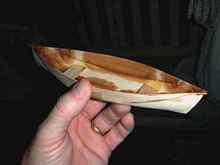|
While waiting for epoxy to cure on the Bufflehead, I've
given into temptation and modeled up a one sheet design
that has been in my head for quite some time. I was messing
with a long scrap of 1/16" basswood modeling wood,
bending it into numerous shapes, when I first had the idea
for a compound bend that would probably break some old rules
written for stiff plywood. I think this type of bend at
the bow would only work with a wood like 4m Okoume as it
is much more flexible than Meranti, Luan or Fir. The other
part of the idea was that I could get some pretty nice shapes
out of a rectangular piece of wood and create a shapely
two chine hull. The shape of the hull is pretty much controlled
by the bottom panels.
 |
The bottom on the model is basically two pieces 1 foot
by about 7-1/2 feet, with a stem curve at the ends (the
angle [and curve] at the ends will control the shape of
the bow and stern). The shape of the flotation bulkheads
will also help determine the shape. Athwartships at the
beam, the bottom has a slightly rounded shape. I just realized
that the bottom chines resemble Robb White's tin canoe (May
his tribe increase).
 |
The bottom and ends are stitched, then the center is spread
out (ignore the "seats" in the picture - those
were just to hold the shape on the model. Flotation bulkheads
would be placed to help spread the sides). Some type of
jig would probably be needed to keep the bottom from trying
to hog upward until the sheer is put on. The sides are basically
1 by 8 feet with a very basic curve from the corners down
to the center. There are two resulting triangular pieces
that can be used for the bulkheads and short decks (unless
you want real breasthooks).
A note here: what I have described is a big wooden spring
trap. There is a lot of torque. I haven't worked out whether
it could safely be done using a normal stitch-n-glue and
still keep some rocker on the bottom. I'm thinking with
the right jig or form, it could. Perhaps I may come up with
something on the next model.
Something I found nice was that the sides are smooth flush
with the bottom chine at the ends and form a chine down
below the waterline amidships, which would look pleasing
but still provide about as much stability as you could expect
in a one sheeter. I guess this might be called a tiny canoe.
If two sheets were scarphed to 4x12 or 4x14, you might make
a case for a pirogue or decked canoe. I think that the same
basic formula might work with varying lengths and widths.
Beam at bottom is about 24 inches and about 30 inches at
sheer as modeled. Sorry for the messy glue job on the little
model; neatness wasn't the goal on this one. When I get
time, I'll try a neat job at 2"=1' and get some accurate
drawings. Heck, I might just build it and do some messing
about on the golf course pond down the street.
This type of hull shape has been floating around in the
right side of my brain for some time, held in check by the
left side, which apparently broke down in the heat this
weekend. Here's another idea: imagine installing a nice
little stern instead of a canoe stem on a 12 foot version
and you might have a nice little Hillbilly Whitehall to
row around the cowpond.
Well, the epoxy has cured. Time to start back on the Bufflehead.
Disclaimer: The writer isn't a boat designer, but has shared
drinks with one or two. The attached drawing is a best-guess
at a cutting layout and profile. No assumptions should be
made as to the safety, integrity or sanity of this design.
*****

|

